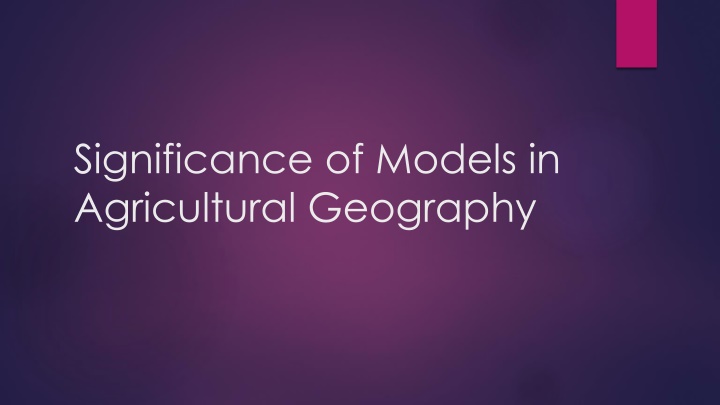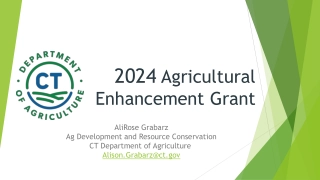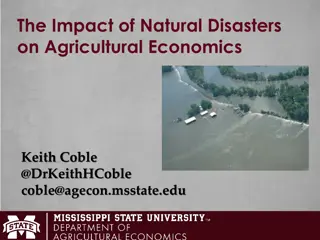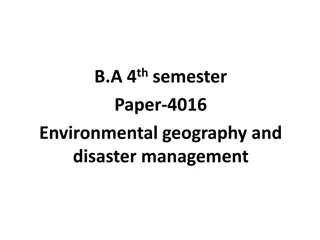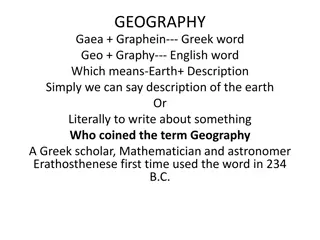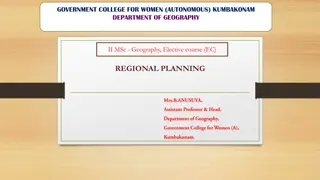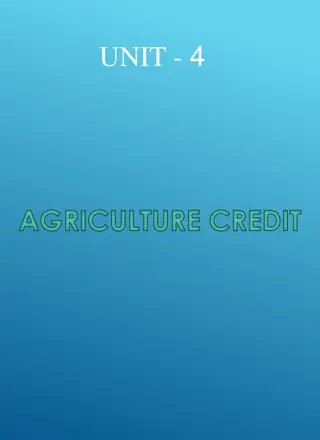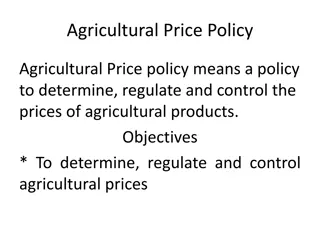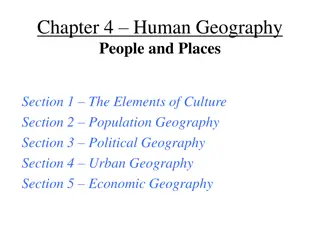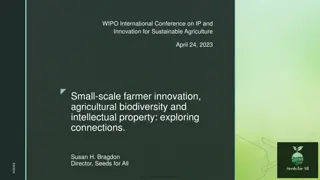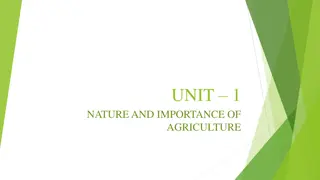Significance of Models in Agricultural Geography
Models play a crucial role in various disciplines, including agricultural geography, by offering a simplified and hypothetical representation of complex phenomena. When used correctly, models help in understanding reality and empirical investigations, but misuse can lead to dangerous outcomes. Longmans Modern English Dictionary defines models as representations idealized to demonstrate specific properties of segments of reality in a simplified and accurate form. Models, as suggested by Clark, serve to relate observations to theoretical ideas, simplifying complex observations by highlighting important interrelationships. The universal view of models, as explained by Skilling, encompasses a broad range of applications, from theories and laws to spatial and historical models, providing a simplified explanation of phenomena on Earth's surface.
Download Presentation

Please find below an Image/Link to download the presentation.
The content on the website is provided AS IS for your information and personal use only. It may not be sold, licensed, or shared on other websites without obtaining consent from the author.If you encounter any issues during the download, it is possible that the publisher has removed the file from their server.
You are allowed to download the files provided on this website for personal or commercial use, subject to the condition that they are used lawfully. All files are the property of their respective owners.
The content on the website is provided AS IS for your information and personal use only. It may not be sold, licensed, or shared on other websites without obtaining consent from the author.
E N D
Presentation Transcript
Significance of Models in Agricultural Geography
Models are quite essential in the various disciplines of the Arts and Sciences, such as geography, geology, economics, sociology, anthropology, psychology, archaeology and some aspects of biology, since it is only through the use of models that the diversity and complexity of a phenomenon can be comprehended. They are operational tools with the help of which one can understand reality, not the whole reality, but nevertheless, a useful and comprehensible segment of it. At the same time, if models are not used properly, they might prove dangerous. The misapplication of models would nullify the effect of the otherwise efficacious model-using building. approach and model For a clear comprehension and appreciation of a phenomenon or a combination of phenomena, models are considered to be the most important tools in empirical investigations.
Longmans Modern English Dictionary lists the usage of the term model as a noun, as an adjective, and as a verb: (i) a three dimensional representation, (ii) serving as or suitable to be a model, and (iii) to make a model (representation) of, respectively. In fact a part of all these dictionary meaning of a model are incorporated in its scientific usage as: Model is an idealized representation of reality in order to demonstrate some of the properties of its segment in a simplified and an accurate form .
Models as suggested by Clark, are pieces of machinery that relate observations to theoretical ideas; they may be used for different purposes. They vary widely with the form of machinery they employ, the class of observations they focus upon, and the manner in which they relate observations in theory. In geographic usage, parts of machinery mean statistical methods; observations imply actual distributions in terms of percentages, conventional units, etc. and theoretical ideas account for ideal theoretical distributions. Models simplify the representation of complex observations by selectively eliminating minor observations, isolating the important ones, and highlighting their interrelationships.
The universal view of models, as expounded by Skilling, is that a model can be a theory, law, hypothesis or structured idea. It can be a relation or an equation; it can be a synthesis of data. From a geographic point of view, it includes reasoning about reality in a spatio-temporal perspective, thus giving rise to spatial as well as historical models. A model offers a simplified and hypothetical description and explanation of the interaction of phenomena on the earth s surface or a true comprehension of what actually happens in real life.
An agricultural geographer uses models as vital elements in his research to explain the observed phenomena, relationship studies and classification geographical thinking. Model building in the geography of agriculture is obviously as important as in other disciplines. Hagget (1966) and Hagget et al. (1977) have stressed the necessity and role of model building in human geography because: It is a procedure used for making a guided and relevant analysis based on meaningful categories of data, and for generating hypothesis from the skeletal expression of a theoretical distribution. or regionalization based on
It is economical for interpretation and useful as teaching aid since it allows us to pass on generalized information in a highly compressed form. The use of models as teaching aids was discussed by Chorley and Hagget in 1965. Models have a special value in the understanding as well as presenting of information of geographical interest; such structures seem to provide especially appropriate frameworks for both research and teaching. The teaching of geography has been badly wanting in such models because geographers have been prejudiced against their use despite their viability as pedagogic tools. For example, the Davisian physiographic model, which is a cyclical model explaining he three stages in a cycle of erosion, has proved useful as a teaching aid.
Moreover, model building helps in discovering fresh facts, and leads to further research and modifications; it stimulates the development of further research models, and makes clear those areas of research where improvement is necessary. Agricultural complexity exists as a patterned diversity; it is, therefore, essential to explore it by the use of simplified patterns of symbols, equations, laws, principles, and methods. The model splits the complexities into a series of simplified systems and thus achieves in one act an overview of the essential characteristics of a domain. Successful models are those which manage to handle complex and varied geographic patterns, concentrations, relationships. These simplify interpretation without bringing into play any kind of extraneous influences. In short, the role of models in the geography of agriculture is to codify what has been experienced in the past, to explain contemporary agricultural patterns and to initiate a fresh line of inquiry. combinations, and
